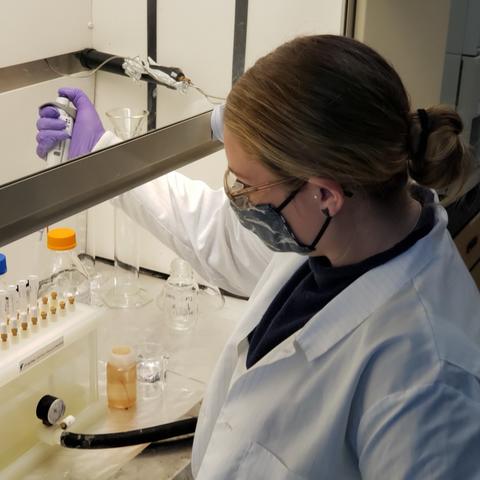
Alix Rodowa in the lab figuring out how to accurately measure PFAS in drinking water.
Water has fascinated postdoctoral researcher Alix Rodowa since her days in a high school environmental science club. Now, she takes a sample of life at NIST in Charleston, South Carolina, as part of her ongoing fight against a persistent, potentially cancer-causing set of chemicals entering our drinking water.
With the best of intentions in the 1960s, the U.S. military commissioned per- and polyfluoroalkyl substances (PFAS) for use on hydrocarbon-based fuel fires. Training for firefighters took place in concrete-lined pits, and, with nowhere else to go, the chemicals from the foams seeped into the ground beneath. Around the same time, PFAS found a home in a number of other sectors including consumer products, manufacturing, and to a lesser extent pesticides.
More than 50 years later, some of the chemicals linger. These remnants of the fire-smothering foams don’t break down in the environment. Even today, samples of groundwater taken near the now-unused training pits can often appear foamy.
The resiliency of PFAS is resulting in an accumulation in our groundwater and drinking water akin to that of a tub with a broken faucet that steadily fills up. These synthetic compounds can build up within the food chain, too, and gather inside the organs of the creatures that eat them. If that isn’t enough cause for concern, studies suggest some PFAS could cause cancer, liver damage and other diseases.
But to learn more about PFAS, we need to first accurately measure them. That’s why Alix and her colleagues at NIST are in the midst of projects to:
- Develop a reference material of PFAS from groundwater affected by the foams, so that labs across the country can ensure the accuracy of their measurements as they study these “forever chemicals.”
- Trace the origins of PFAS, identifying the chemicals that come from the firefighting foams versus other sources (pesticides, textile coatings, etc.).
A sense of discovery — the idea that her work is uncovering something nobody else in the world might know about — keeps Alix coming back to the lab every day. And Alix’s measurement work with PFAS in water could start a ripple effect of additional discovery, since the compounds are now accumulating attention among environmental groups, government agencies, manufacturers and individual consumers.
Follow us on social media for more like this from all across NIST!

